Amsterdam set to join China rail freight trail

Amsterdam will next year join the growing band of European locations providing a direct rail freight service to China as part of the modern incarnation of the historic ‘Silk Road’. The Port of Amsterdam will be the starting point for the first service in the spring to the trade hub of Yiwu in Shanghai region.
The TMA Terminal at Amsterdam’s Amerikahaven port is working with Nunner Logistics, an agent of the Austrian-based Rail Cargo Group, to provide the service, which will depart on March 14. It will travel 11,000 kilometres through Germany, Poland, Belarus, Russia and Kazakhstan, arriving in China three weeks later.
‘Valuable extension’
The Port of Amsterdam says its link to the new Silk Road ‘is as old as the traditional route itself’, and is touting the rail option being touted as the perfect opportunity to provide customers with access to an enormous market. Koen Overtoom, Port CEO, sees this new connection as a valuable extension of the multimodal services already available at the port.
“This dedicated connection will provide permanent access to a vast and remote hinterland, which is really unique,” he said. “It will cement our already strong position as a European logistic hub and will enhance our short-sea connections to Britain and Scandinavia.”
Hinterland
Both Nunner Logistics and the Rail Cargo Group, the second largest rail transporter in Europe, are working closely with the TMA terminal, using the facility for the storage and transhipment of all types of cargo, including steel to be transported to the hinterland by rail, barge and truck.
The Silk Road started out as a network of caravan routes through Central Asia, which was used for many centuries as a trade route between China and East Asia on one side, and the Middle East and Mediterranean on the other. The Silk Route was the main path connecting East and West, China and Europe. The route owes its name to the lucrative silk trade, which emerged during the Han Dynasty between 206 BCE and 220 CE. The new version of the Silk Road is part of China’s ‘One Belt, One Road’ economic programme. The train journey takes 16 to 18 days – almost twice as fast as by ship. Carbon emissions are 20 times lower than those produced by air cargo.
You just read one of our premium articles free of charge
Want full access? Take advantage of our exclusive offer





